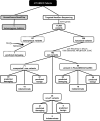Assessing the spectrum of germline variation in Fanconi anemia genes among patients with head and neck carcinoma before age 50
- PMID: 28678401
- PMCID: PMC5853120
- DOI: 10.1002/cncr.30802
Assessing the spectrum of germline variation in Fanconi anemia genes among patients with head and neck carcinoma before age 50
Abstract
Background: Patients with Fanconi anemia (FA) have an increased risk for head and neck squamous cell carcinoma (HNSCC). The authors sought to determine the prevalence of undiagnosed FA and FA carriers among patients with HNSCC as well as an age cutoff for FA genetic screening.
Methods: Germline DNA samples from 417 patients with HNSCC aged <50 years were screened for sequence variants by targeted next-generation sequencing of the entire length of 16 FA genes.
Results: The sequence revealed 194 FA gene variants in 185 patients (44%). The variant spectrum was comprised of 183 nonsynonymous point mutations, 9 indels, 1 large deletion, and 1 synonymous variant that was predicted to effect splicing. One hundred eight patients (26%) had at least 1 rare variant that was predicted to be damaging, and 57 (14%) had at least 1 rare variant that was predicted to be damaging and had been previously reported. Fifteen patients carried 2 rare variants or an X-linked variant in an FA gene. Overall, an age cutoff for FA screening was not identified among young patients with HNSCC, because there were no significant differences in mutation rates when patients were stratified by age, tumor site, ethnicity, smoking status, or human papillomavirus status. However, an increased burden, or mutation load, of FA gene variants was observed in carriers of the genes FA complementation group D2 (FANCD2), FANCE, and FANCL in the HNSCC patient cohort relative to the 1000 Genomes population.
Conclusions: FA germline functional variants offer a novel area of study in HNSCC tumorigenesis. FANCE and FANCL, which are components of the core complex, are known to be responsible for the recruitment and ubiquitination, respectively, of FANCD2, a critical step in the FA DNA repair pathway. In the current cohort, the increased mutation load of FANCD2, FANCE, and FANCL variants among younger patients with HNSCC indicates the importance of the FA pathway in HNSCC. Cancer 2017;123:3943-54. © 2017 American Cancer Society.
Keywords: Fanconi anemia; germline variations; head and neck cancers; recessive inherited disorders; squamous cell carcinoma.
© 2017 American Cancer Society.
Figures


Similar articles
-
Loss of heterozygosity in FANCG, FANCF and BRIP1 from head and neck squamous cell carcinoma of the oral cavity.Int J Oncol. 2017 Jun;50(6):2207-2220. doi: 10.3892/ijo.2017.3974. Epub 2017 Apr 24. Int J Oncol. 2017. PMID: 28440438
-
Variation in cisplatinum sensitivity is not associated with Fanconi Anemia/BRCA pathway inactivation in head and neck squamous cell carcinoma cell lines.Cancer Lett. 2007 Jan 8;245(1-2):75-80. doi: 10.1016/j.canlet.2005.12.028. Epub 2006 Feb 7. Cancer Lett. 2007. PMID: 16466850
-
Analysis of a FANCE Splice Isoform in Regard to DNA Repair.J Mol Biol. 2015 Sep 25;427(19):3056-73. doi: 10.1016/j.jmb.2015.08.004. Epub 2015 Aug 12. J Mol Biol. 2015. PMID: 26277624
-
Fanconi anaemia and cancer: an intricate relationship.Nat Rev Cancer. 2018 Mar;18(3):168-185. doi: 10.1038/nrc.2017.116. Epub 2018 Jan 29. Nat Rev Cancer. 2018. PMID: 29376519 Review.
-
Current knowledge on the pathophysiology of Fanconi anemia: from genes to phenotypes.Int J Hematol. 2001 Jul;74(1):33-41. doi: 10.1007/BF02982547. Int J Hematol. 2001. PMID: 11530803 Review.
Cited by
-
Conserved function of Drosophila Fancd2 monoubiquitination in response to double-strand DNA breaks.G3 (Bethesda). 2022 Jul 29;12(8):jkac129. doi: 10.1093/g3journal/jkac129. G3 (Bethesda). 2022. PMID: 35595243 Free PMC article.
-
Fanconi anemia and dyskeratosis congenita/telomere biology disorders: Two inherited bone marrow failure syndromes with genomic instability.Front Oncol. 2022 Aug 25;12:949435. doi: 10.3389/fonc.2022.949435. eCollection 2022. Front Oncol. 2022. PMID: 36091172 Free PMC article. Review.
-
Fanconi anemia and homologous recombination gene variants are associated with functional DNA repair defects in vitro and poor outcome in patients with advanced head and neck squamous cell carcinoma.Oncotarget. 2018 Apr 6;9(26):18198-18213. doi: 10.18632/oncotarget.24797. eCollection 2018 Apr 6. Oncotarget. 2018. PMID: 29719599 Free PMC article.
-
A pathogenic germline BRCA2 variant in a patient with hypopharyngeal squamous cell carcinoma.Clin Case Rep. 2020 Nov 25;9(1):429-432. doi: 10.1002/ccr3.3548. eCollection 2021 Jan. Clin Case Rep. 2020. PMID: 33489192 Free PMC article.
-
Squamous Carcinoma of the Oral Cavity in Patient with Fanconi Anemia: A Challenging Reconstruction with Double-barrel Free Fibula Flap Case Report.Plast Reconstr Surg Glob Open. 2023 Nov 20;11(11):e5414. doi: 10.1097/GOX.0000000000005414. eCollection 2023 Nov. Plast Reconstr Surg Glob Open. 2023. PMID: 38025634 Free PMC article.
References
-
- Wang AT, Smogorzewska A. SnapShot: Fanconi anemia and associated proteins. Cell. 2015;160:354–e1. - PubMed
MeSH terms
Substances
Grants and funding
LinkOut - more resources
Full Text Sources
Other Literature Sources
Medical
Miscellaneous

